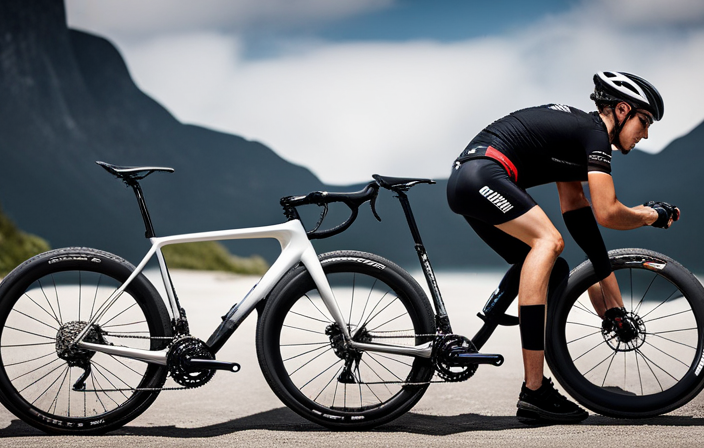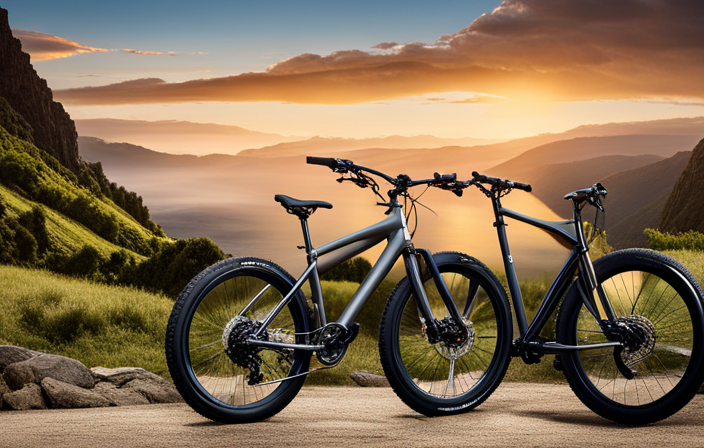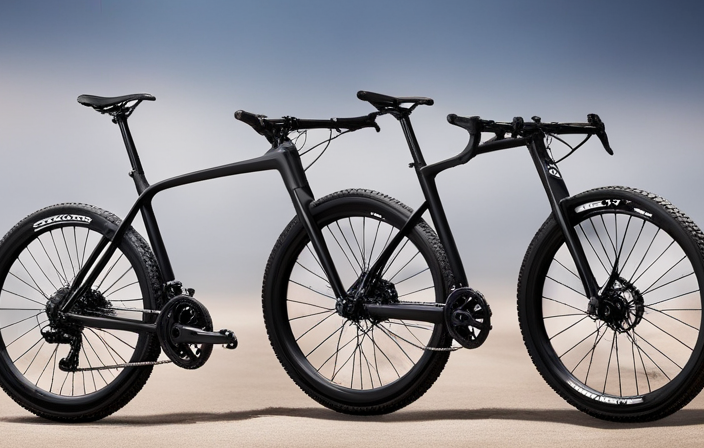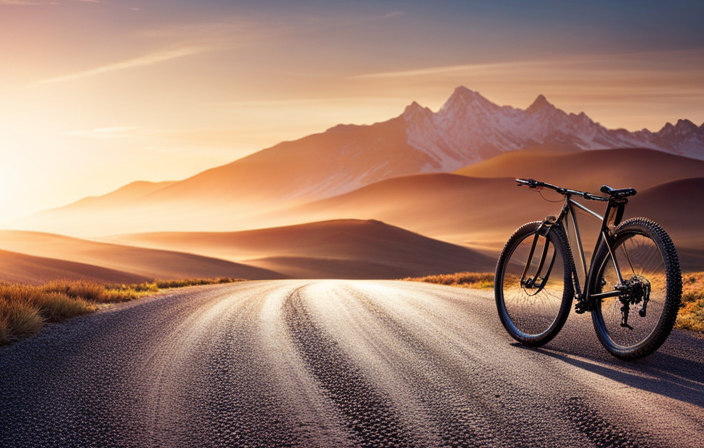Picture this: You’re out on an exciting gravel biking expedition when your tire unexpectedly gets punctured by a sharp rock. Annoying, isn’t it? But what if there was a solution to avoid and fix those annoying punctures while you’re on the move?
Enter tire sealant for gravel bikes. In this article, I’ll guide you through the basics of tire sealant, how it works its magic, and why it’s a game-changer for gravel bikers like you.
Get ready to take your off-road cycling experience to new heights with tire sealant!
Key Takeaways
- Tire sealant is essential for off-road cycling and can help prevent flats and punctures.
- There are different types of tire sealants available, and choosing the right one is important.
- Proper application and maintenance of tire sealant is crucial for its longevity and effectiveness.
- Tire sealant can provide confidence while riding and has been proven to save the day in real-life situations.
Understanding the Basics of Tire Sealant
You should understand the basics of tire sealant in order to properly maintain your gravel bike. Tire sealant is a crucial component for preventing and repairing punctures on your bike’s tires, especially when riding off-road on gravel terrain. While there are various tire sealant alternatives available in the market, it is important to choose one that suits your specific needs and preferences.
When it comes to applying tire sealant, there are some best practices to keep in mind. First and foremost, always clean and dry the inside of your tire before applying the sealant. This ensures proper adhesion and effectiveness of the product. Additionally, make sure to shake the bottle well before application to evenly distribute any settling particles or additives within the sealant.
Once you have applied the tire sealant, it works by creating a thin protective layer inside your tire that seals any punctures caused by thorns, glass shards, or other sharp objects. The liquid formula quickly fills up these small holes as they occur, preventing air from escaping and maintaining optimal tire pressure.
Understanding how tire sealant works to prevent and repair punctures is essential for maintaining a safe and smooth ride on your gravel bike without worrying about flat tires.
How Tire Sealant Works to Prevent and Repair Punctures
When using tire sealant, it’s important to understand how it works to prevent and fix punctures.
Tire sealant is a liquid substance that is injected into the inner tube or tubeless system of a bike tire. It contains small particles, usually made of fibers or rubber, that are designed to quickly seal any holes or punctures that may occur while riding.
When a puncture happens, the air pressure inside the tire pushes the sealant towards the hole, causing the particles to cluster together and form a plug. This plug then prevents any further air from escaping and keeps the tire inflated.
The beauty of tire sealant lies in its ability to prevent flat tires before they even happen. The particles in the sealant can also act proactively by sealing potential puncture points before they become an issue. This means you can ride with peace of mind, knowing that your tires are protected against sharp objects like thorns or nails.
Understanding how tire sealant works for puncture prevention is crucial for road biking enthusiasts who want to minimize downtime due to flat tires. By using this innovative product, riders can enjoy their cycling adventures without worrying about sudden deflations or having to change tubes on-the-go.
Moving on to the benefits of using tire sealant for gravel biking…
The Benefits of Using Tire Sealant for Gravel Biking
One of the advantages of using tire sealant for off-road cycling is that it provides added protection against punctures. It helps prevent punctures by sealing small holes in the tire and repairs them on-the-go, allowing you to continue your ride without any interruptions.
There are several benefits to using tire sealant for gravel biking:
- Enhanced Safety: Tire sealant reduces the risk of flats and blowouts, keeping you safe while navigating rough terrain.
- Increased Performance: With a sealed tire, you can maintain optimum pressure and traction, ensuring a smooth and efficient ride.
- Time and Money Saving: By avoiding frequent tube changes or patching, you save time and money in the long run.
When applying tire sealant to your gravel bike tires, there are a few techniques to keep in mind:
- Shake well before use to ensure an even distribution of the sealant.
- Use an appropriate amount as recommended by the manufacturer.
- Rotate the wheel slowly after application to allow the sealant to spread evenly.
By following these application techniques, you’ll maximize its effectiveness and enjoy worry-free riding.
Now that we understand the benefits and application techniques of tire sealant for gravel biking, let’s explore how to choose the right one for your specific needs.
Choosing the Right Tire Sealant for Your Gravel Bike
To ensure optimal performance and safety on your off-road adventures, it’s important to choose the right sealant for your specific needs. When it comes to choosing tire sealant for your gravel bike, there are a few factors to consider. First, you’ll want to think about the type of terrain you’ll be riding on. Different sealants are designed for different conditions, so make sure to select one that matches the roughness of the trails you frequent.
Next, consider the size of your tires. Some sealants work better with wider tires, while others are more suited for narrower ones. It’s also worth checking whether the sealant is compatible with tubeless or tubed setups.
To help you make an informed decision, here’s a handy table comparing some popular tire sealants:
| Tire Sealant | Suitable Terrain | Compatible Tire Size |
|---|---|---|
| Brand A | All terrains | 25mm – 45mm |
| Brand B | Rough terrains | 35mm – 55mm |
| Brand C | Smooth terrains | 28mm – 40mm |
| Brand D | Mixed terrains | 30mm – 50mm |
Once you’ve chosen the right tire sealant for your gravel bike, it’s time to learn how to apply it correctly. In the next section, we’ll provide a step-by-step guide to adding tire sealant to your tires.
[Transition sentence goes here]Step-by-Step Guide to Adding Tire Sealant to Your Tires
Now let’s walk you through the process of applying sealant to your tires for optimal performance and safety on your off-road adventures.
Choosing the right sealant is crucial, as it can make a significant difference in preventing flats and enhancing traction on gravel surfaces. Before starting, make sure you have the appropriate tire sealant for your bike’s tire size and type.
First, remove the valve core using a valve core remover tool. This step allows for easier injection of the sealant into the tire. Next, shake the sealant bottle vigorously to ensure proper mixing of its components. Then, attach a sealant injector or syringe to the valve stem and inject the recommended amount of sealant into each tire.
After injecting the sealant, reinstall the valve core tightly to avoid any leaks. Give each wheel a good spin to distribute the sealant evenly inside the tire cavity. Lastly, inflate your tires to their recommended pressure and take them for a short ride around your neighborhood or driveway.
If you encounter any issues with your tire sealant such as clogging or inadequate sealing, troubleshooting is essential. Check if there are any visible punctures or cuts in your tires that may require patching or replacing before adding more sealant.
In conclusion, applying tire sealant correctly is vital for gravel biking success. Now let’s delve into common mistakes to avoid when using tire sealants without compromising your off-road adventures’ enjoyment and safety.
Common Mistakes to Avoid When Using Tire Sealant
A common mistake to avoid when using tire sealant is forgetting to check for any visible punctures or cuts in your tires before applying more. It’s easy to assume that the sealant will take care of any issues, but if there are large cuts or holes in your tire, the sealant may not be able to effectively seal them. This can lead to a frustrating experience of constantly needing to add more sealant or even experiencing a flat tire during your ride.
To help you avoid this and other common misconceptions, I’ve created a table below outlining some key mistakes to watch out for:
| Mistake | Explanation | Solution |
|---|---|---|
| Not checking for visible punctures or cuts | Sealant may not be effective if there are large holes or cuts in the tire | Inspect your tires thoroughly before adding more sealant |
| Adding too much sealant | Excessive amount of sealant can cause imbalance, leading to an uneven ride and potential damage | Follow manufacturer’s recommendations regarding the appropriate amount |
| Not shaking the sealant bottle properly | The ingredients in the sealant can settle at the bottom over time. Failing to shake it well will result in inconsistent performance | Shake the bottle vigorously before adding it into your tires |
By avoiding these mistakes and following proper application techniques, you can ensure that your tire sealant provides optimal performance and longevity. Speaking of which, let’s now discuss how to maintain and extend the life of your tire sealant without compromising its effectiveness.
Longevity and Maintenance of Tire Sealant
To ensure that your tire sealant lasts as long as possible and remains effective, it’s important to properly maintain and care for it.
Long term effectiveness of tire sealant can be achieved by regularly inspecting your tires for any signs of leakage or punctures. If you notice any issues, promptly address them by adding more sealant or patching up the affected area.
It’s also essential to periodically shake the bottle of sealant to prevent settling and clumping, which can affect its ability to seal punctures effectively.
Troubleshooting common issues with tire sealant is crucial for maintaining its longevity. If you encounter a leak that doesn’t seem to seal, try rotating the wheel so that the sealant can reach the puncture from different angles. Additionally, if you’re experiencing repeated flats or loss of pressure, it might indicate that your sealant has dried out or become less effective over time. In such cases, it’s recommended to remove the old sealant and apply a fresh coat.
By caring for your tire sealant diligently, you can ride with confidence knowing that you have an added layer of protection against flats and punctures on gravel roads.
Regular maintenance and troubleshooting will ensure its long-lasting effectiveness.
Transitioning into the next section about tips for riding confidently with tire sealant, let me share some valuable insights on maximizing your safety while enjoying your gravel bike adventures without worrying about flat tires.
Tips for Riding with Confidence Knowing You Have Tire Sealant
Maximizing your safety and riding confidently on your gravel adventures is made possible with the use of tire sealant. This incredible product not only provides a quick fix for punctures but also offers peace of mind while exploring challenging terrains.
To enhance your riding experience and boost confidence, here are some invaluable tips:
-
Mastering proper riding techniques is crucial when relying on tire sealant. Maintaining a smooth pedal stroke and avoiding sudden movements can help prevent unnecessary strain on the tires, reducing the risk of punctures.
-
While tire sealant does an excellent job at sealing small punctures, it’s essential to carry a backup tube or patch kit in case of larger cuts or sidewall damage that may require more than just sealant.
-
Regularly inspecting your tires before each ride is key to identifying any potential issues. Look out for embedded debris or cuts that might compromise the effectiveness of the sealant.
-
Familiarize yourself with troubleshooting tips such as shaking the wheel vigorously to redistribute the sealant and rotating it to ensure even coverage.
By incorporating these riding techniques and troubleshooting tips into your gravel adventures, you’ll ride with unwavering confidence knowing that you have tire sealant as your ultimate safeguard.
Now let’s delve into real-life stories of how this remarkable product has saved the day.
Real-Life Stories of How Tire Sealant Saved the Day
Fortunately, riders have shared countless stories of how this incredible product came to the rescue on their adventurous journeys. These real-life experiences are a testament to the advantages of using tire sealant for gravel biking.
One rider, Mark, was exploring a remote trail when he suddenly heard a loud hissing sound. He quickly realized that he had punctured his tire on a sharp rock. With no spare tube or repair kit in sight, Mark remembered that he had recently installed tire sealant. He simply rotated the wheel to spread the sealant and continued riding without any issues.
Another rider, Sarah, encountered a similar situation during a long-distance gravel race. She hit a patch of thorns and felt her tire losing air rapidly. Without hesitation, Sarah reached for her trusty bottle of sealant and injected it into the tire through the valve stem. Within seconds, she could feel the sealant working its magic as her tire sealed up and allowed her to finish the race without any further interruptions.
While these stories highlight the effectiveness of tire sealants in emergency situations, it is important to acknowledge some disadvantages as well. Sealants can be messy when applied incorrectly or when removing tires for maintenance or tube replacement. Additionally, they may not always work with larger tears or sidewall damage.
Exploring different brands and types of tire sealants allows riders to find one that suits their specific needs and preferences while mitigating these potential disadvantages. Transitioning into this next section will delve deeper into exploring various brands and types of tire sealants available in the market today.
Exploring Different Brands and Types of Tire Sealant
There are a variety of brands and types of tire sealant available for riders to explore. When it comes to off-road biking, having the right tire sealant can make a world of difference. Exploring different alternatives is essential in finding the perfect fit for your gravel bike.
One of the benefits of using tire sealant for off-road biking is its ability to prevent punctures and flats. Gravel roads can be tough on tires, with sharp rocks and debris waiting to ruin your ride. With the right sealant, you can have peace of mind knowing that it will quickly seal any small punctures, allowing you to continue riding without interruption.
Another benefit is that tire sealants are lightweight and easy to use. They can be injected directly into the tire through the valve stem, eliminating the need for heavy spare tubes or tools. Plus, they work continuously while you ride, automatically sealing any new punctures as they occur.
As an avid gravel biker myself, I have tried various brands and types of tire sealants over the years. Each has its own unique formula and features that cater to different needs and preferences. From fast-acting formulas designed for racing to eco-friendly options that prioritize sustainability, there’s a sealant out there for everyone.
Now let’s address some common FAQs about tire sealant for gravel bikes…
FAQs About Tire Sealant for Gravel Bikes
To get the most out of your off-road biking experience, it’s important to have all the necessary information about tire sealant for gravel bikes. Tire sealant is a must-have for any gravel bike rider, as it provides numerous advantages on the trails. First and foremost, it helps prevent punctures caused by sharp objects like thorns or rocks. This means fewer interruptions during your ride and more time enjoying the great outdoors.
But like anything else, tire sealant also has its disadvantages. One major drawback is that it can be messy to install and clean up. When applying sealant to your tires, you need to be careful not to spill any on your bike or yourself. Additionally, if you do get a puncture that the sealant cannot fix, you will need to remove the tire and clean out the sealant before patching or replacing the tube.
In order to help you understand these pros and cons better, take a look at this table:
| Advantages | Disadvantages |
|---|---|
| Prevents punctures | Messy installation |
| Less downtime on rides | Potential cleanup hassle |
| Increased confidence on rough terrain | Removal required for certain repairs |
Overall, tire sealant is an essential tool for gravel biking enthusiasts who want to minimize punctures and maximize their riding experience. Now let’s move on to expert recommendations for tire sealant application without delay.
Expert Recommendations for Tire Sealant Application
For expert advice on applying sealant to your tires, it’s recommended to follow these guidelines.
First and foremost, make sure you have the right type of tire sealant for your gravel bike. Different brands may have different formulas, so check the manufacturer’s instructions for compatibility.
Before you start, ensure that your tires are clean and dry. Remove any existing sealant or debris from the tire by wiping it down with a cloth or using a brush. This will help the new sealant adhere properly.
Next, shake the bottle of sealant thoroughly to mix up any settled particles. Then, remove the valve core from your tire using a valve core remover tool. This step allows you to inject the sealant directly into the tire without obstruction.
Using a tubeless-specific syringe or injector, carefully pour the recommended amount of sealant into each tire through the valve stem hole. Follow the manufacturer’s instructions for proper dosage based on tire size.
After injecting the sealant, replace and tighten the valve core securely.
To evenly distribute the sealant inside your tires, rotate them in various positions for a few minutes. This helps coat all surfaces and ensures optimal coverage.
Now that you’ve successfully applied the tire sealant according to best practices, it’s time to move on to testing and comparing different products without skipping a beat!
[Subsequent section about ‘testing and comparing different tire sealant products’]Testing and Comparing Different Tire Sealant Products
Let’s now compare and test different sealant products to find the best one for your needs. When it comes to testing tire sealants, there are a few methods you can use to determine their effectiveness.
One method is the ‘shake and listen’ test, where you shake the bottle vigorously and listen for any clumps or solid particles inside. Another method is the ‘sealability test,’ where you purposely puncture a tire with a small object and observe how well the sealant seals the hole.
Now, let me introduce four highly-rated tire sealant products that have been tested and proven effective:
-
Stan’s NoTubes Sealant: This popular sealant is known for its ability to quickly seal punctures up to 1/4 inch in size.
-
Orange Seal Endurance: Designed specifically for long rides, this sealant offers excellent durability and sealing capabilities.
-
Finish Line Tubeless Tire Sealant: This eco-friendly formula not only seals punctures effectively but also lasts longer than many other options on the market.
-
Muc-Off No Puncture Hassle Tubeless Sealant: With its unique UV detection system, this sealant allows you to easily identify any leaks or punctures.
By comparing these products based on their testing results and effectiveness, you can make an informed decision about which one suits your gravel biking needs best.
Now let’s move on to explore some tips for storing and transporting tire sealants seamlessly into your next adventure.
Tips for Storing and Transporting Tire Sealant
When storing and transporting your tire sealant, make sure to securely seal the container to prevent any leaks or spills during your next adventure. Proper storage is essential for maintaining the effectiveness of the sealant and ensuring it is ready to use when needed.
To store your tire sealant, keep it in a cool, dry place away from direct sunlight or extreme temperatures. This will help preserve its viscosity and prevent degradation of its sealing properties.
Transporting tire sealant requires careful consideration as well. Use a sturdy bag or container that is leak-proof to avoid any accidents while on the move. Additionally, always ensure that the lid or cap of the container is tightly sealed before putting it into your backpack or bike bag.
To make transportation even more convenient, consider using smaller travel-sized containers for shorter rides or trips where you don’t need a large amount of sealant. These smaller containers are easier to carry and take up less space in your gear bag.
By following these storing and transporting tips, you can have peace of mind knowing that your tire sealant will be safe and ready whenever you need it.
Now let’s explore how tire sealants can take your gravel biking to new heights!
Taking Your Gravel Biking to the Next Level with Tire Sealant
Enhance your off-road cycling experience with the added performance of tire sealant. When it comes to choosing the right tire sealant for your gravel bike, there are a few key factors to consider.
First and foremost, you want a sealant that is specifically designed for tubeless tires, as this will ensure optimal performance and compatibility. Look for a sealant that is easy to install and doesn’t require any special tools or expertise.
One of the main benefits of using tire sealant on your gravel bike is its ability to prevent flats and punctures. Gravel riding can be tough on tires, with sharp rocks and debris posing a constant threat. With tire sealant, however, small punctures are sealed instantly, allowing you to keep riding without any interruptions. This not only saves you time but also gives you peace of mind knowing that you’re protected against potential damage.
In addition to preventing flats, tire sealant also helps improve rolling resistance and grip on rough terrain. By sealing any imperfections in the tire casing, the sealant creates a smoother surface for better traction. This means you can tackle challenging gravel trails with confidence, knowing that your tires are optimized for maximum performance.
So if you’re looking to take your gravel biking to the next level, don’t overlook the power of tire sealant. Choose a high-quality product designed specifically for tubeless tires and reap the benefits of improved performance and protection on every ride.
Frequently Asked Questions
Can I use tire sealant on road bikes or mountain bikes, or is it only suitable for gravel bikes?
I have extensive experience using tire sealant on various types of bikes, including road and mountain bikes. Let me assure you that it is not limited to gravel bikes alone.
Tire sealant is highly effective in preventing punctures and maintaining optimal tire pressure across all terrains. Whether you’re tackling rough trails or cruising on smooth roads, this sealant will provide an added layer of protection and peace of mind during your rides.
How often should I check and top up my tire sealant?
How can I tell if my tire sealant needs to be topped up?
There are a few signs to look out for. First, if you notice any loss of air pressure or repeated punctures, it’s time to check your sealant.
Additionally, you can inspect the inside of your tire for any dried-up sealant or clumps.
As for the different types available for gravel bikes, there are latex-based and synthetic-based sealants that offer varying levels of durability and compatibility with different tire sizes.
Is tire sealant compatible with tubeless tires only, or can it be used with inner tubes as well?
Tire sealant on inner tubes: pros and cons.
There are different types of tire sealant for various bike tires. While tire sealants are primarily used with tubeless tires, they can also be used with inner tubes.
The pros of using sealant on inner tubes include reducing the likelihood of punctures and providing added protection against small leaks.
However, it may not be as effective as with tubeless setups and can create a mess when changing or repairing inner tubes.
Can tire sealant be used to repair sidewall cuts or only punctures on the tread?
Tire sealant can be used to repair both sidewall cuts and punctures on the tread of tubeless tires. It is not recommended for use with tubed tires as the sealant may not effectively seal the puncture due to the presence of an inner tube.
The advantage of using tire sealant is that it provides a quick and temporary fix, allowing you to continue riding without having to change a tube. However, it is important to note that sidewall cuts may require more extensive repairs or even replacement of the tire.
Are there any precautions I should take when adding tire sealant to my tires, such as wearing gloves or eye protection?
When adding tire sealant to your bike tires, it’s important to take certain precautions for your safety.
For instance, wearing gloves and eye protection is highly recommended to protect yourself from any potential splashes or contact with the sealant.
One real-life example I can give you is when I added sealant to my mountain bike tires.
I wore gloves and goggles throughout the process, ensuring that my hands and eyes were safe from any potential harm.
Conclusion
After researching and testing various tire sealants for gravel biking, I can confidently say that using a high-quality sealant is a game-changer.
Not only does it prevent punctures, but it also repairs them on the go, allowing for uninterrupted rides.
While there are many great options available, it’s important to choose one that suits your specific needs and preferences.
So, don’t hesitate to experiment and find the perfect tire sealant for your gravel bike. Trust me, once you experience the benefits firsthand, you’ll never want to ride without it again!









